Geese are one of the world’s largest waterfowl and some of the most beautiful types of birds. There are many types of geese, each of which is uniquely patterned and has unique characteristics.
Geese are very loyal. Whether you’re looking to learn more about geese or are just curious about keeping them as pets, this guide will provide you with helpful information about the different types of geese.
Geese spend most of their lives looking after their mate and offspring. They are often misunderstood due to their occasional aggressive nature, but geese have many qualities that make them special.

What Is A Goose?
A goose is a large water bird that is bigger than a duck but smaller than a swan. This bird belongs to the Anatidae family.
A goose can refer to a male or female bird; however, females are more commonly called a “goose,” and males are called a “gander.”
Geese have long necks and legs and look like large ducks. Their bills are moderately flattened, and their plumage comes in many colors.
Unlike ducks, geese don’t quack but make more of a honking sound. Geese are physically similar to swans, only slightly smaller, with black and gray feathers. Some species of geese are pure white.
Large geese can reach a weight of 10 pounds and have a wingspan of 6 feet.
Geese live in many different habitats provided they are close to a water source. This is often freshwater sources like lakes, marshes, wetlands, ponds, and streams.
Geese are relatively popular birds, and different types of geese are found worldwide. The only place you won’t find geese is Antarctica.
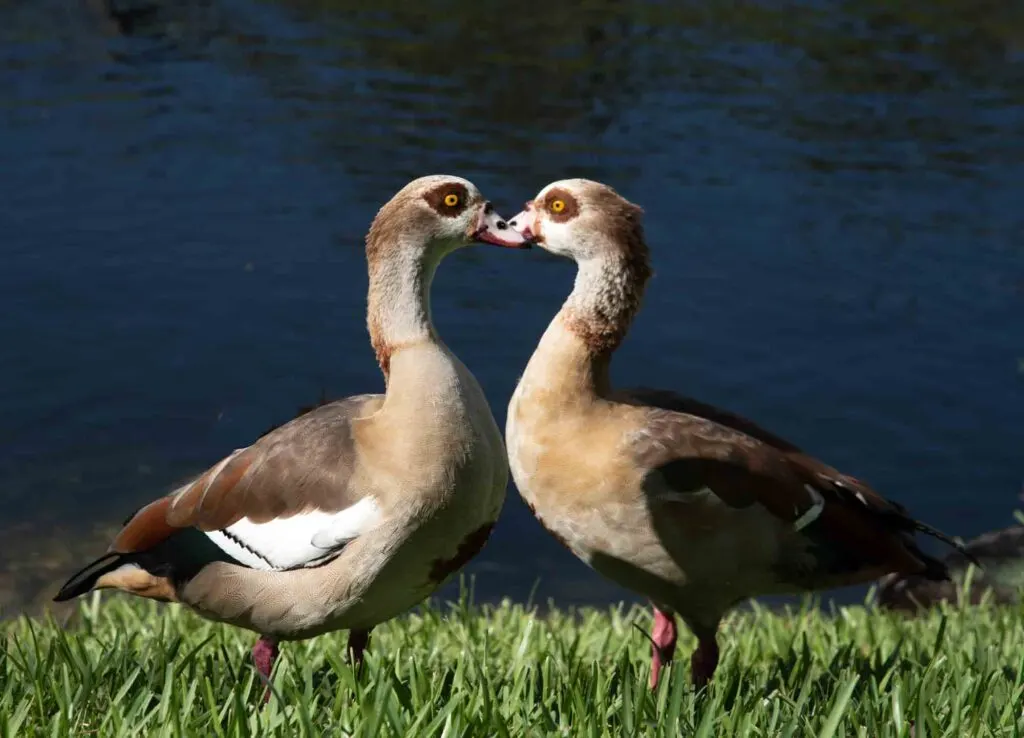
Goose Types
The Anatidae family contains various species of waterfowl, including geese. This group includes the Anser and Branta genera.
The Anser genus includes gray and white geese and has 11 living species. The largest goose in this genus is the graylag goose which reaches a weight of 5.5 to 9 pounds.
Geese classified under the Anser genus have specific characteristics that include pink and orange legs and feet, bills that are pink, orange, and black and white plumage underneath their body, with some species having white on their heads.
It’s important to note that the white geese in the Anser genus were also separated into the genus Chen. The geese that fall under this genus are the snow goose, Ross’s goose, and the emperor goose.
Black geese fall under the Branta genus and have distinctly black coloring on their bills, head, and neck.
Geese that are in this category have feet and legs that are dark gray and black.
Some geese species in this genus have white markings and mostly white plumage underneath and on their upper tail regions.
These geese types are much smaller than most, but some species are known to be almost as large as some swan species, like the black-necked swan.
Geese species that fall under the Branta genus are the brant goose, barnacle goose, and cackling goose.
Goose breeds are also grouped into weight classes which include light, medium, and heavy.
Heavy goose breeds weigh between 18 and 26 pounds and include the African goose, the Toulouse goose, and the Embden goose.
These goose breeds are mainly used for exhibitions and as domestic geese. The Embden and Toulouse goose are also reared for meat consumption.
The medium goose breeds include the American buff, the pomeranian goose, and the Sebastopol goose.
These medium-sized geese weigh between 12 to 18 pounds. They are the most widely kept goose breeds and mature much faster than large ones. These geese are used for eggs and meat and kept as pets.
The lightweight geese are widely used on farms. The tufted Roman and Chinese goose are two of the most popular lightweight goose breeds.
Chinese geese are excellent egg layers. Lightweight geese weigh between 10 and 12 pounds and are three feet tall.
19 Fascinating Types of Geese
Here are some of the most interesting types of geese you can spot in nature.
1. Brant Goose

One of the most interesting types of geese is the brant goose (Branta bernicla). This goose breed falls under the Branta genus. The brant goose is a small breed and weighs between 1.9 and 4.9 pounds.
There are three subspecies: the dark-bellied brant goose, the pale-bellied, and the black brant goose.
The brant goose typically has a pure white under the tail, a black tail, and a black or gray body.
The brant goose is mainly found across America, Europe, and Asia, and their habitat primarily consists of lagoons, coasts, and islands.
Their diet once consisted of seaweed, sea grass, and sea lettuce, but due to environmental changes began moving inland and now feed on grasses and grains.
The brant goose looks for estuaries, coastlines, and bays in winter.
This breed of goose often gets mistaken for a duck due to its small size and shorter neck. They migrate yearly, fly over 3,000 miles, and have a unique salt gland that allows them to drink salt water.
2. Greater White-Fronted Goose
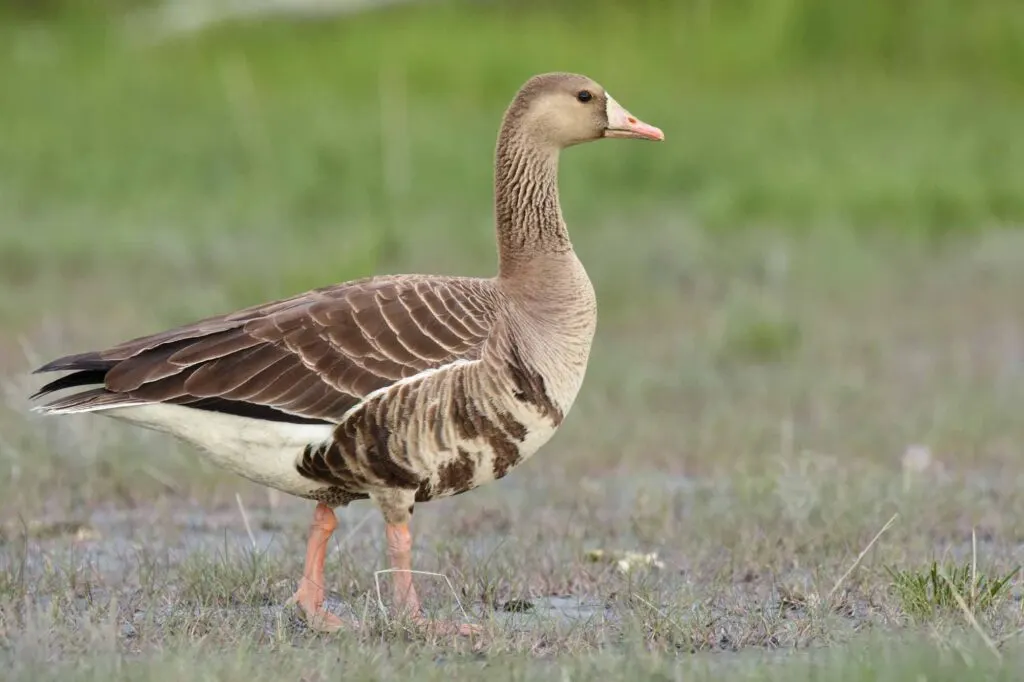
The greater white-fronted goose (Anser albifrons) weighs between 4.3 and 7.3 pounds, has bright orange legs, and is primarily brown.
The male is generally larger than the females, and both genders are similar in color. These geese make various sounds but are most recognizable for their high-pitched cackle.
The greater white-fronted goose is found in North America and most of the northern hemisphere.
During the winter, large flocks of the greater white-fronted goose breed in the arctic tundra in wetlands and farmlands.
These geese eat grasses, berries, seeds, and grain in the summer. However, their diet is more limited during the winter, and they’ll mainly feed on grasses.
Their habitat consists of marshes, lakes, bays, and prairies. A few interesting facts about the greater white-fronted goose are that they are monogamous and migrate together and have a family bond greater than any other species of geese.
3. Spur-Winged Goose
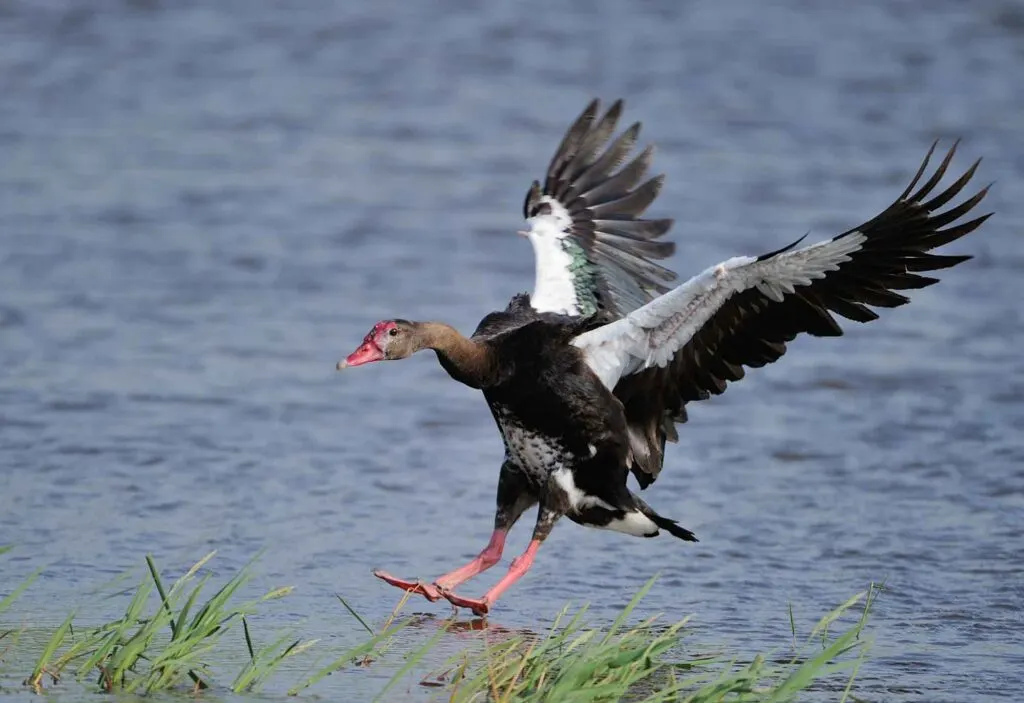
Spur-winged geese are waterfowl found in sub-Saharan Africa. They like to stay near rivers, lakes, and seasonal pools.
They are the largest African waterfowl and are, on average, the world’s largest wild “goose,” although in average weight, their size is at least rivaled by the Cape Barren goose.
Because of their high-speed wings, spur-winged geese can reach the speed of 89 miles per hour, which makes them one of the fastest-flying birds in the world.
Adult spur-winged geese can reach a length between 30 to 45 inches, and their average weight ranges between 8.8 to 15 pounds.
Males of this particular species are typically larger in size than females. The wingspan of these geese can range between 59 to 79 inches.
4. Pink-Footed Goose
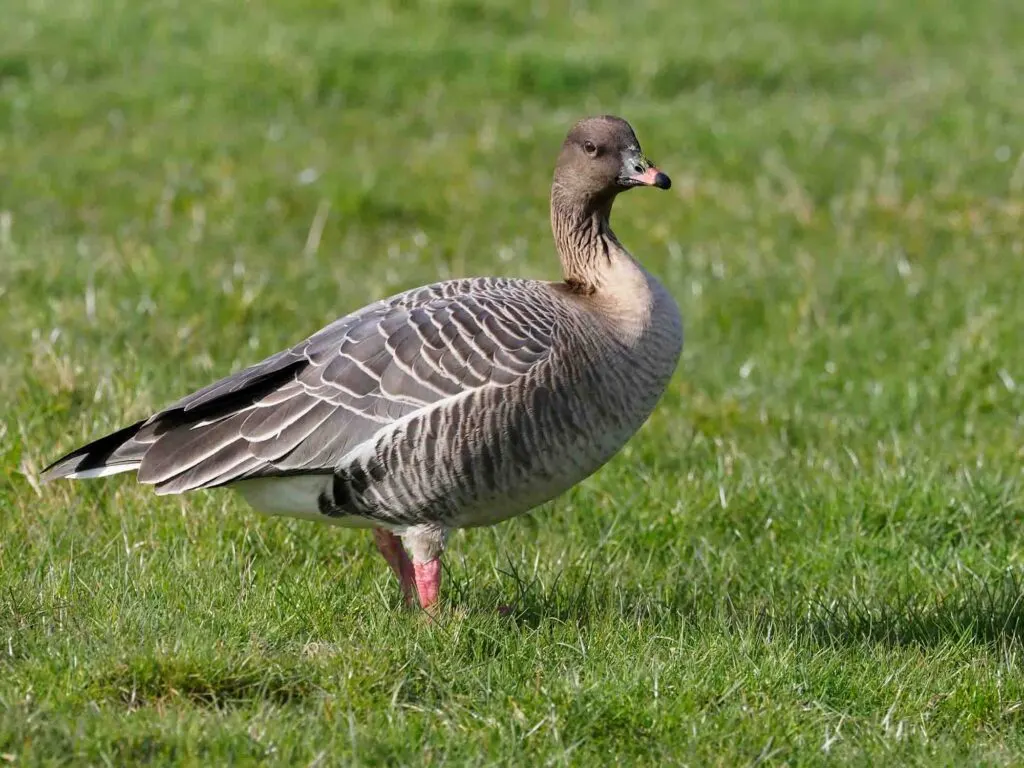
The pink footed goose (Anser brachyrhynchus) is a medium breed of goose that weighs between 4 and 7.5 pounds.
The pink-footed goose is one of the types of geese with a couple of striking features, including pink feet and a short bill that’s pink and black.
The body is gray-brown, the neck is dark brown, and the underside and the rest of the body are streaked with white.
The pink-footed goose is found in Greenland, Iceland, and Svalbard. In the winter, they migrate to regions like the Netherlands, Denmark, Germany, Belgium, and Norway.
Pink-footed geese are found in estuaries, wetlands, meadows, mudflats, and farmlands. Their diet includes tundra plants, sugar beetles, potatoes, and grasses.
Pink-footed geese have a lifespan of 20 years and are very vocal birds making honking calls as they fly. Pink-footed geese are remarkable and fly in flocks with over 40,000 birds.
5. Ross’s Goose
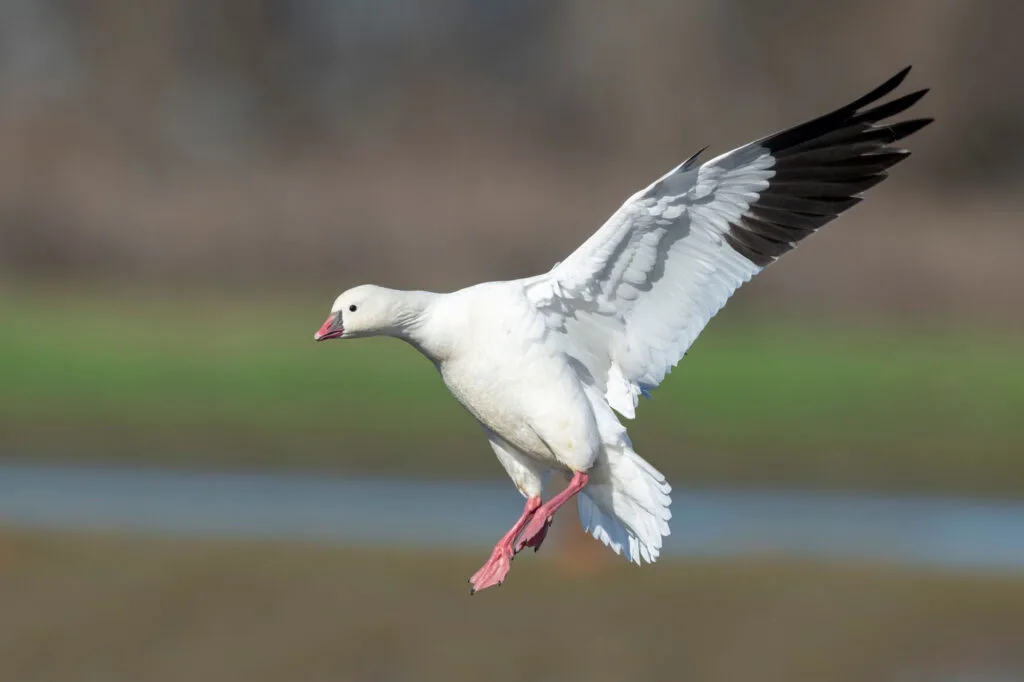
The Ross’s goose (Anser rossii) looks similar to the white snow goose but much smaller.
This breed of goose is easily identified due to its white body, black wing tips, and short neck. These geese weigh between 3 to 4 pounds.
Ross’s geese are found on islands, wetlands, meadows, and agricultural regions, but their habitat during the winter is lakes and reservoirs, where they commonly roist with other bird species.
The Ross’s geese prefer a primarily vegetarian diet and eat grasses, moss, lichens, and sedges.
They are predominantly found in the Arctic tundra, Canada, and the United States but migrate to places like Mexico during the winter.
The Ross’s goose is always white, but there is an exception; occasionally, you’ll find a dark-colored Ross’s goose.
Most of these geese are located in the Canadian Arctic; in fact, 95% live in the Queen Maud Gulf Migratory Bird Sanctuary in Canada.
6. Chinese Goose
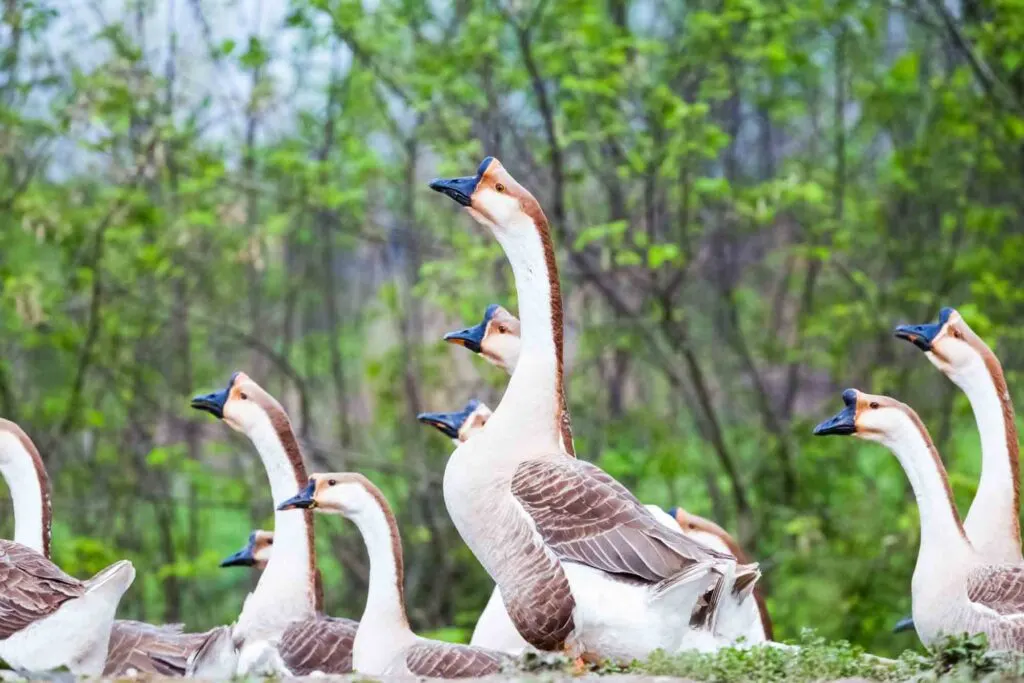
Chinese geese are one of the geese types that are incredible egg layers. Chinese geese can lay between 60 to 100 eggs in the breeding season.
Chinese geese (Anser cygnoides domesticus) are most well-known for the basal knob on their bill.
These fascinating birds are believed to have originated in China, and today there are more than 20 breeds of Chinese geese.
There are two varieties of Chinese goose, a gray variety and a brown variety.
This species of geese always have orange feet with a black bill and a long neck. The Chinese goose weighs between 10 and 12 pounds.
These geese primarily feed on grasses and are often kept as domestic pets for their egg-laying capabilities and weeding. Grass is usually their single food source, but their diet can also consist of clovers, bluegrass, bromegrass, leaves, sedges, and aquatic plants.
Chinese geese are also called “swan geese” due to their long necks and gracefulness.
The Chinese goose is found all over the United States and in Mongolia, Russia, and China. They are highly adaptable geese and can survive in almost any climate.
Chinese geese prefer a habitat close to a small body of water for grooming, drinking, and splashing.
These geese can be found near lakes, wetlands, grasslands, farms, and estuaries. Surprisingly these geese rarely swim and spend most of their time grazing.
Chinese geese produce a loud worn-out honking sound and usually honk in threes. They have a lifespan of 10 years and have become popular in recent years as domesticated pets.
7. Egyptian Goose
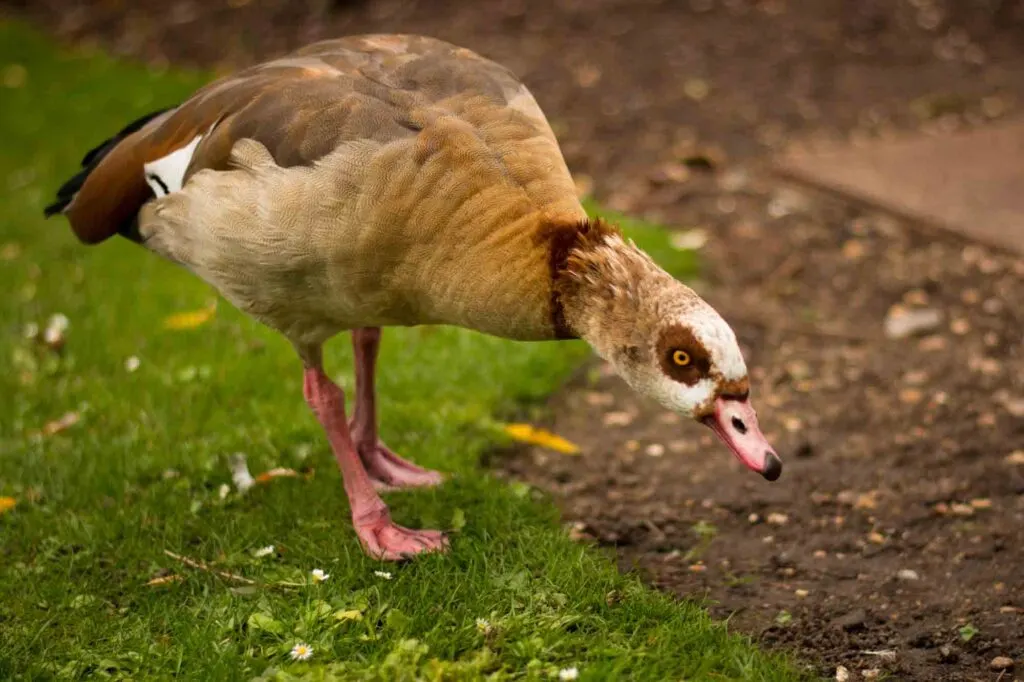
The Egyptian goose (Alopochen aegyptiaca) is native to Africa, but populations can also be found in some parts of the United States, Western Europe, and New Zealand.
The north of Norfolk has the highest distribution of Egyptian geese. These geese were usually kept in ornamental ponds, but today their habitat consists of lowland lakes, rivers, dams, reservoirs, and wetlands.
These ornamental birds are gray or brown in color and white under their wings. The male Egyptian geese are slightly larger than the females, and many reach a weight of 4.5 pounds.
Egyptian geese have a lifespan of 15-25 years, and they are mainly herbivores feeding on seeds, stems, grasses, grains, and vegetables. On occasion, these geese eat locusts and worms.
Males and females of this species are known to be slightly aggressive. However, males are predominantly aggressive during mating season. Chinese geese are a widespread species and are not currently on the endangered list.
The ancient Egyptians considered these types of geese sacred birds, and the Egyptians were the first to domesticate this breed of goose.
The Egyptian goose is not actually identified as a wild goose but a cross between a goose and a duck, often called a “shelduck.”
8. Canada Goose
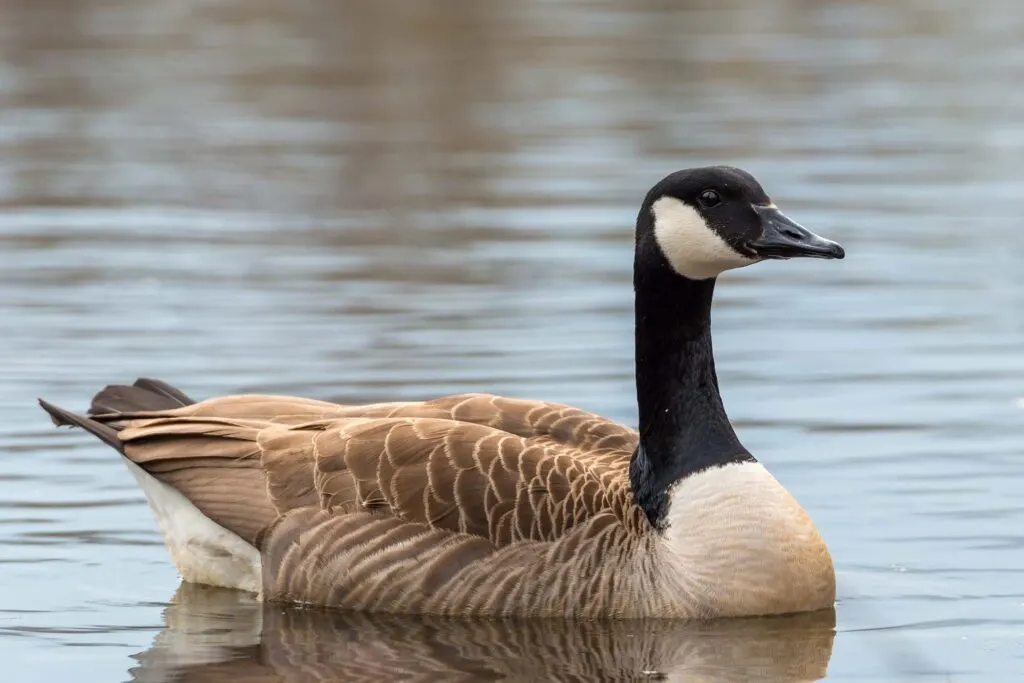
The Canada goose is also called the Canadian goose (Branta Canadensis). This large breed of goose is identified by its white cheeks, black head and neck, and white and brown body.
This North American goose is found in the Arctic and North America, but during migration, this goose travels to northern Europe.
The Canada goose is also found in the U.K., Sweden, Japan, New Zealand, and other parts of the world. These geese weigh between 5 and 14 pounds, with some reaching 20 pounds.
Males weigh more and are larger than females. The Canada goose is prevalent in lakes, bays, marshes, ponds, and agricultural fields, but always look for a place to live near water.
Canadian geese eat a varied diet that includes sedges, aquatic plants, and sedges.
They may eat insects, small fish, and mollusks, but this is not as widely consumed, and their diet mainly consists of plant matter.
Canada geese can travel up to 1,500 miles in a single day and 40 to 70 miles per hour during their migration.
During their molting season, typically one month (June or July), Canadian geese cannot fly because they molt all their feathers at once.
As a survival mechanism, these geese also have the unique ability to imprint on the first thing they see when they hatch.
Likewise, they can imprint on other birds and even humans if their parents aren’t around when they hatch.
9. Orinoco Goose
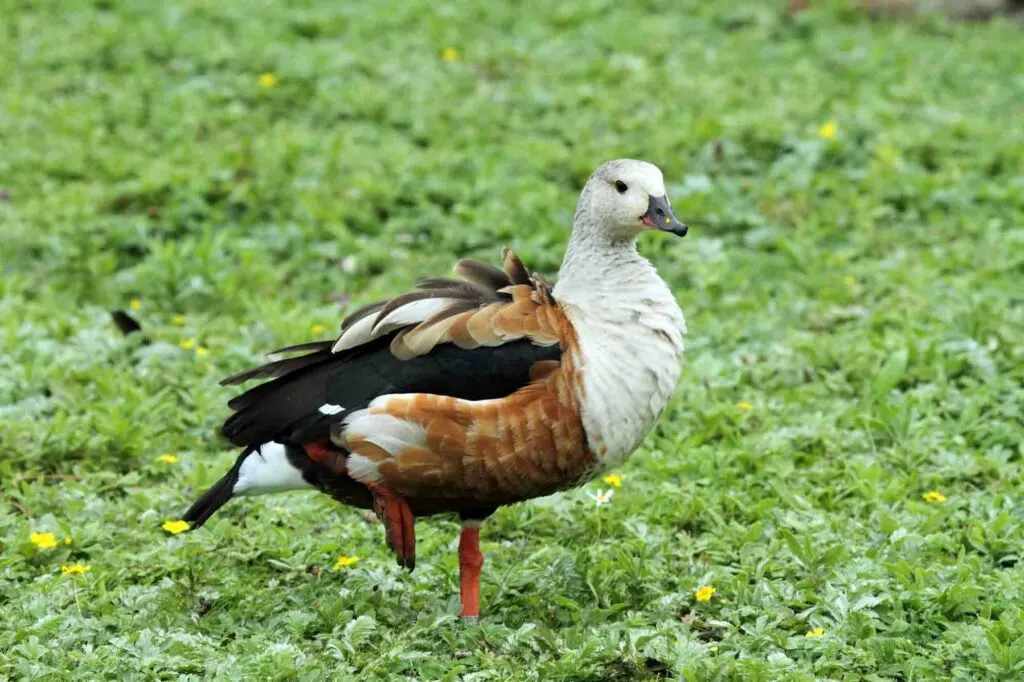
The Orinoco goose is one of the types of geese that is among the near-threatened species of waterfowl.
This goose is native to South America and is one of the species where the male goose and female goose look the same.
The Orinoco goose (Neochen jubata) is a mix of black, white, light brown, or tan and is primarily vegetarian, feeding on aquatic plants, grasses, worms, and small insects.
The Orinoco goose weighs between 2.9 and 4 pounds and inhabits sandy freshwater shores, wetlands, muddy areas, and forest-covered banks.
They also prefer to nest in places off the ground, like hollow logs or trees and rarely nest on the ground.
The male Orinoco goose makes a high-pitched whistling call while the female makes a cackling sound.
This goose was named after South America’s longest river, the Ornico River, and despite its large numbers, they are threatened due to overhunting.
10. Bean Goose
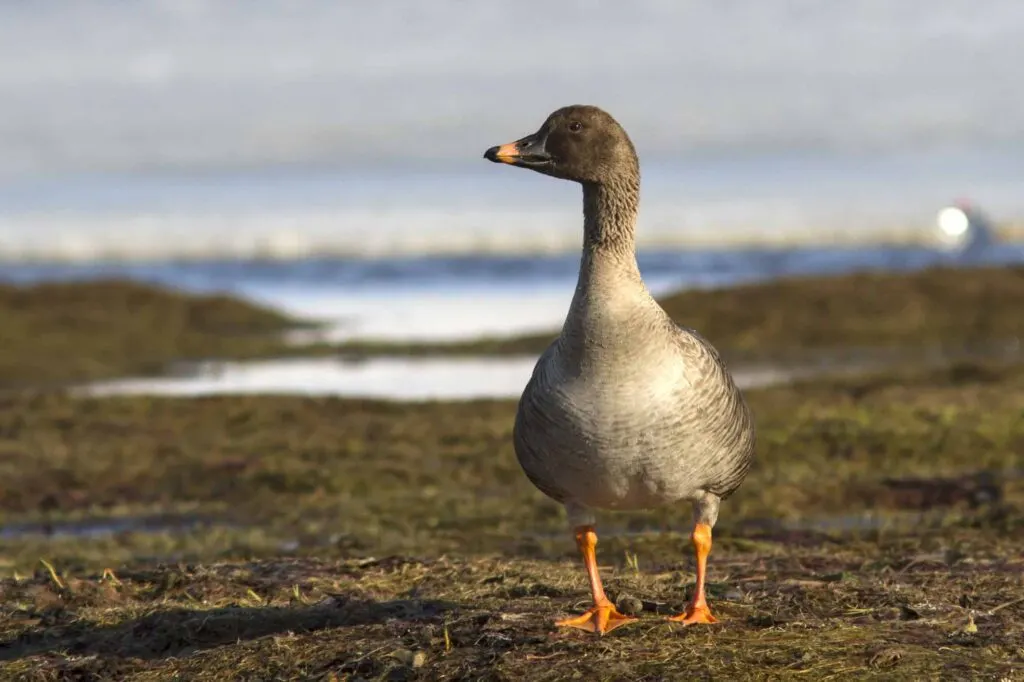
One of the declining geese types is the bean goose. The bean goose (Anser fabalis or Anser serrirostris) is from the Arctic and inhibits pools, meadows, swamps, and rivers.
In winter, the bean goose will seek out agricultural lands and marshes. These geese are found from Western Siberia to Scandinavia but migrate to Western Europe, Scotland, and the east of England during winter.
The bean goose resembles the pink-footed goose but is browner in color and has more plumage.
Instead of pink feet, these geese have yellow feet and a yellow-orange patch on their bill. The bean goose weighs between 6.5 and 8 pounds.
This goose consumes a diet of cereals, potatoes, crops, and grasses. Bean geese are not social geese and prefer to graze in open fields without other animals.
The bean geese get their name from their fondness of grazing bits of what’s left of bean plants in the winter.
11. Emperor Goose
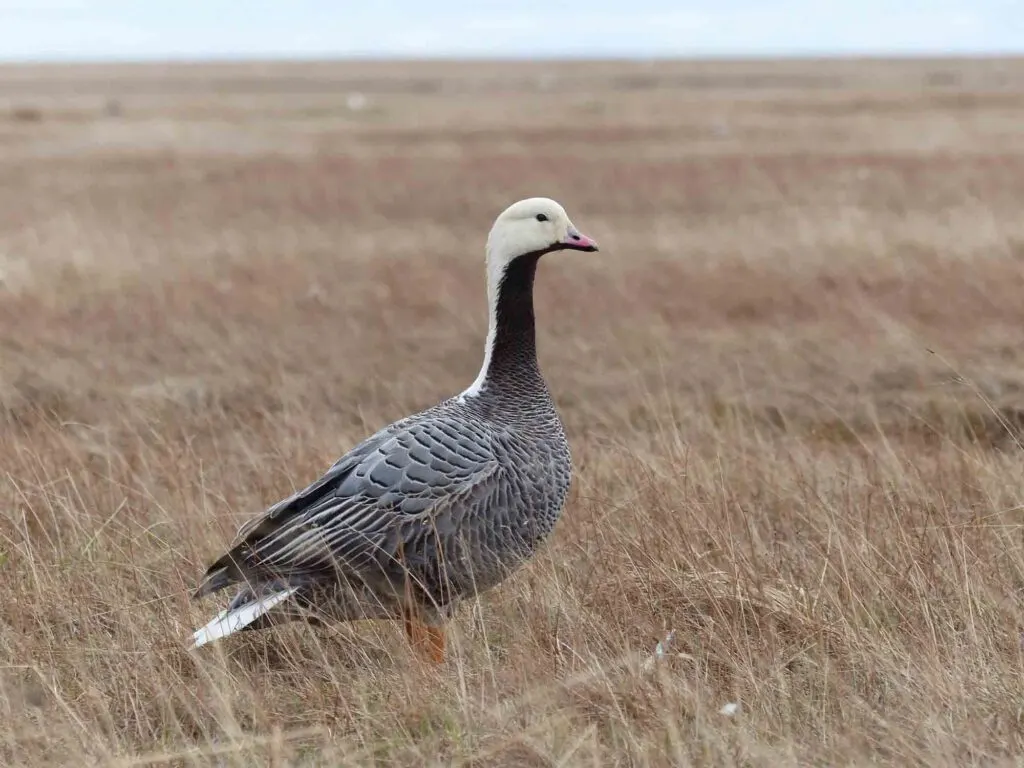
The emperor goose (Anser canagicus) is a smaller type of goose with a silver-gray or blueish body with a white head and orange legs.
Males weigh over 5 pounds, and females weigh around 4 pounds. The emperor goose is larger than the Brant goose but smaller than the greater white-fronted goose.
Emperor geese graze on algae, plant or grass shoots, and root bulbs. These geese also eat barnacles and mussels.
This goose species prefer habitats near the edges of rivers or in the tundra grasslands. The emperor goose is native to Alaska, but most of these geese nest in eastern Russia and the Ukon-Kuskokwin Delta.
In Alaska, the locals call this goose a “beach goose” because of its love of the beach. The oldest recorded emperor goose lived until 20 years old, while most wild emperor geese only live up to 12 years.
12. Snow Goose
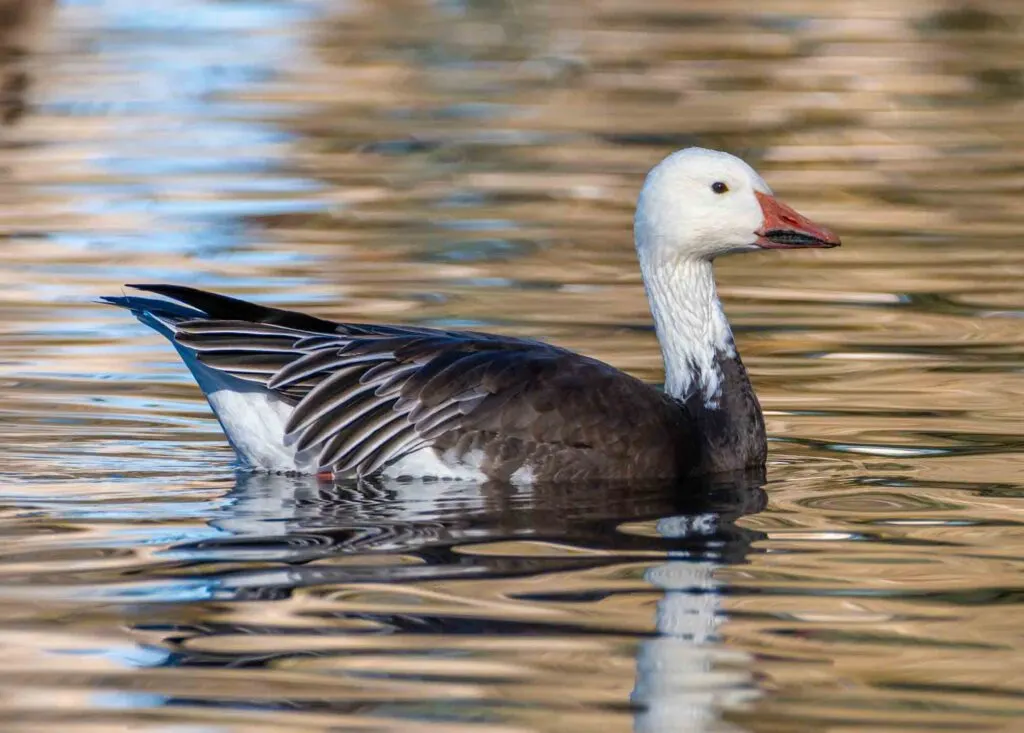
The snow goose is medium in size with a distinctive bill and a long thin neck. Their body is mostly white with black wingtips, but the blue morph is mostly grayish-brown. (Although the blue goose was considered a different species for years.)
The snow goose (Anser caerulescens) is native to North America but migrates to the far north of Canada and Mexico during winter. These geese are also found in Columbia and Greenland.
The male snow goose weighs between 5 and 6.5 pounds, while the females are a bit smaller, weighing between 3.5 and 5 pounds.
The snow goose is a herbivore and eats various plants, including aquatic plants, grasses, and grain. Some of these include willows, sedges, and horsetails.
The habitat of the snow goose includes ponds, streams, marshes, wetlands, and agricultural fields with shallow water. Snow geese migrate in large flocks and return yearly to the same nesting place.
Snow geese pair for life; during mating season, the males dance to attract females. If a white snow goose mates with a dark snow goose, they could get blue goslings.
If there is a pair of two white geese, they are likely to have white goslings.
13. African Goose
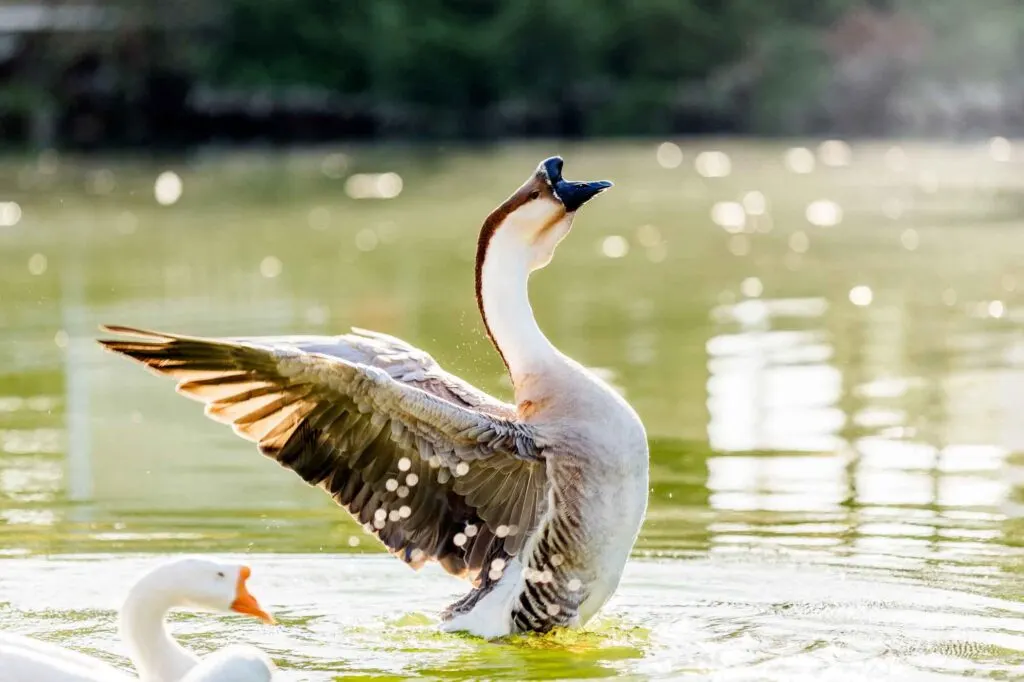
There are many different types of geese. One of these is the African goose.
The African goose (Anser cygnoides) is one of the largest domesticated goose breeds and isn’t a great egg layer, producing only 30 eggs per year.
The African goose likely originated in China, and males can reach a weight of 22 pounds and females 18 pounds.
The African goose is gray, brown, or white and typically lives between 10 and 15 years.
The African goose can survive in many climates, but this species of goose cannot fly due to their curved feathers.
Their diet consists of grass and wheat, and because they are kept as domesticated birds, they are fed commercial feed. If these geese are wild, they eat small aquatic animals, plants, seeds, and snails.
Their habitat is mostly farmlands, and they can be placed in many different environments as long as they have grass and water sources.
The African goose is found worldwide, including in North America and Africa. African geese are highly intelligent and make excellent “guard dogs.”
They are friendly and vocal and are known to be one of the most docile species of geese.
14. Tufted Roman Goose

The tufted Roman goose (Anser anser domesticus) is also commonly called the Roman goose and is a domesticated breed of goose.
This species is one of the oldest types of geese, and depending on where they are found, they are used for many reasons, including exhibitions and meat production.
This goose is located in Australia, North America, and Europe but is thought to have originated in Italy.
They are a small breed of geese that are adaptable to most climates. They have a calm and pleasant temperament, but some males can display aggressive behaviors.
The tufted Roman goose can weigh between 9 and 12 pounds. These geese are usually white, with blue eyes, and have reddish-orange legs, with their most striking feature being the tuft on their heads.
Males and females look the same. Their diet mainly consists of insects, and they are often kept as pets for their incredible ability to control pests.
However, they can also feed on plants, grasses, and commercial feed.
15. Swan Goose
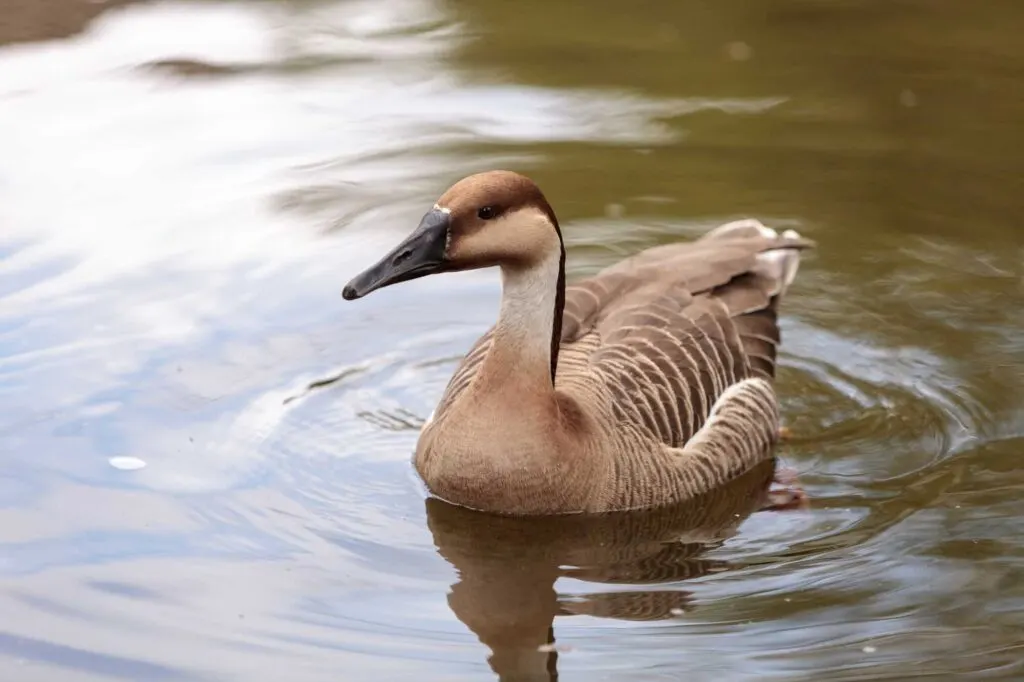
The swan goose (Anser cygnoides) is found in China, Mongolia, and the east of Russia.
This species of goose is not typically found in the wild but is a domesticated breed of goose.
The swan goose has a long neck and weighs between 6.2 and 7.7 pounds, with the males being slightly larger than the female geese.
The swan goose has a vegetarian diet consisting of grasses and sedges. This goose prefers longer grasses due to the shape of its bill.
Swan geese live near lakes, rivers, and ponds. In summer, they gravitate to higher altitudes; in winter, they migrate south to lower altitudes.
Swan geese only reproduce once a year, laying only 5 or 6 eggs per mating season.
This breed of geese, when kept in a domestic environment, live up to 20 years, and some have been known to live till the age of 40.
16. American Buff Goose
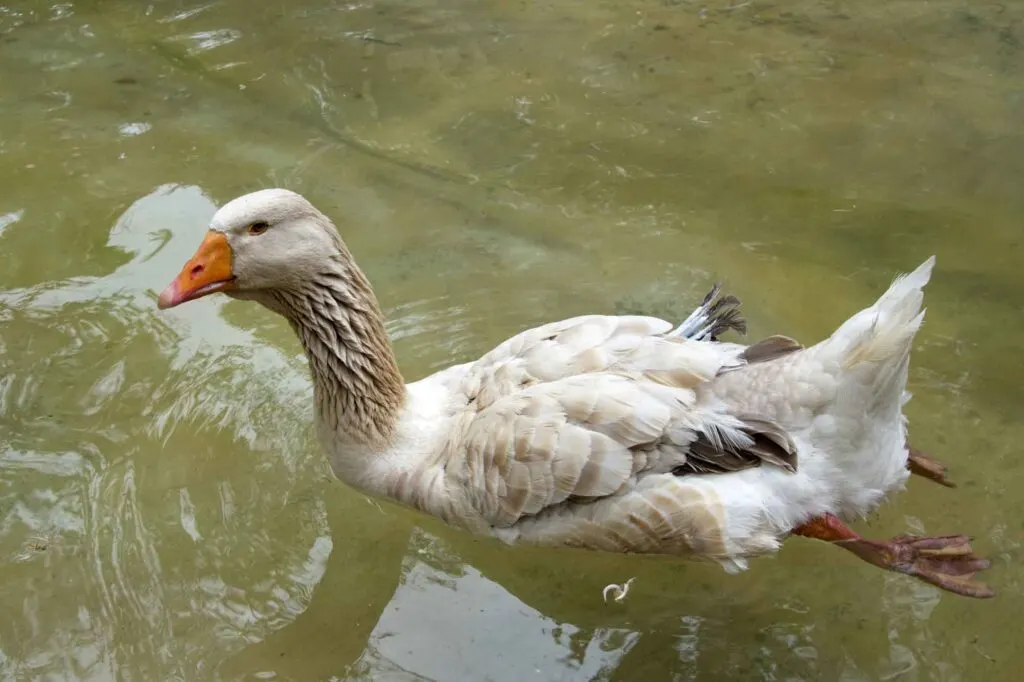
There are many domesticated types of geese, including the American buff goose.
This goose is native to the united states and weighs between 16 and 18 pounds but can reach a weight of 28 pounds.
The American buff goose is believed to have originated from Pomerania.
Although they were once classified as medium-breed geese, they are now considered heavyweight since their size has increased.
They are an easygoing breed that is often reared for meat and eggs. The American buff is an apricot color with bits of white on their bodies.
These geese consume a diet filled with cauliflower, cabbage, spinach, and lettuce. American buff geese are found on small farms and conservation areas and rarely in the wild.
17. Red-Breasted Goose

The red-breasted goose (Branta ruficollis) is a beautifully patterned goose species found in arctic Siberia, Bulgaria, Romania, Ukraine, and some parts of Europe and the U.K.
The red-breasted goose is boldly colored, and their bodies are black and white and a chestnut color.
The red-breasted goose weighs between 2 and 3 pounds and is the smallest species of goose.
This breed of goose prefers habitats close to the water but also lives in grasslands, wetlands, and along the coast.
Red-breasted geese consume a diet of grasses, grains, and aquatic plants and occasionally eat small fish.
During mating season, the red-breasted goose has a specific high-pitched tone and can be very noisy. Males and females of this species look the same, with males being slightly larger.
18. Barnacle Goose
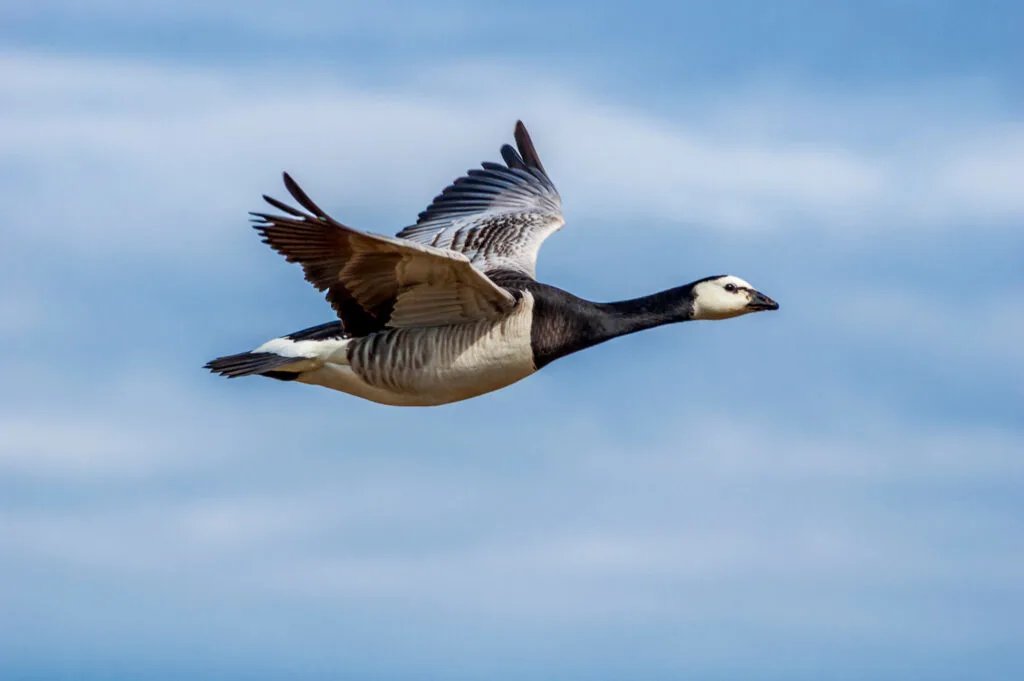
The barnacle goose is one of many different types of geese belonging to the Branta genus. The barnacle goose (Branta leucopsis) is similar to the brant goose.
This is a medium-sized breed of goose weighing between 2.7 and 4.9 pounds. Its body is primarily gray, it has a black neck with a white face and belly.
Barnacle geese are primarily found in England, Scotland, and eastern Greenland. Their habitat consists of cliffs and slopes near lakes, rivers, and marshes.
Barnacle geese can also be found on grasslands and farmlands. This species of geese eat leaves, grasses, roots, and seeds.
Only 50% of a barnacle goose’s offspring will survive due to the harsh conditions they’re exposed to.
They are also prone to be eaten by predators like the Arctic fox and the polar bear.
19. Cackling Goose
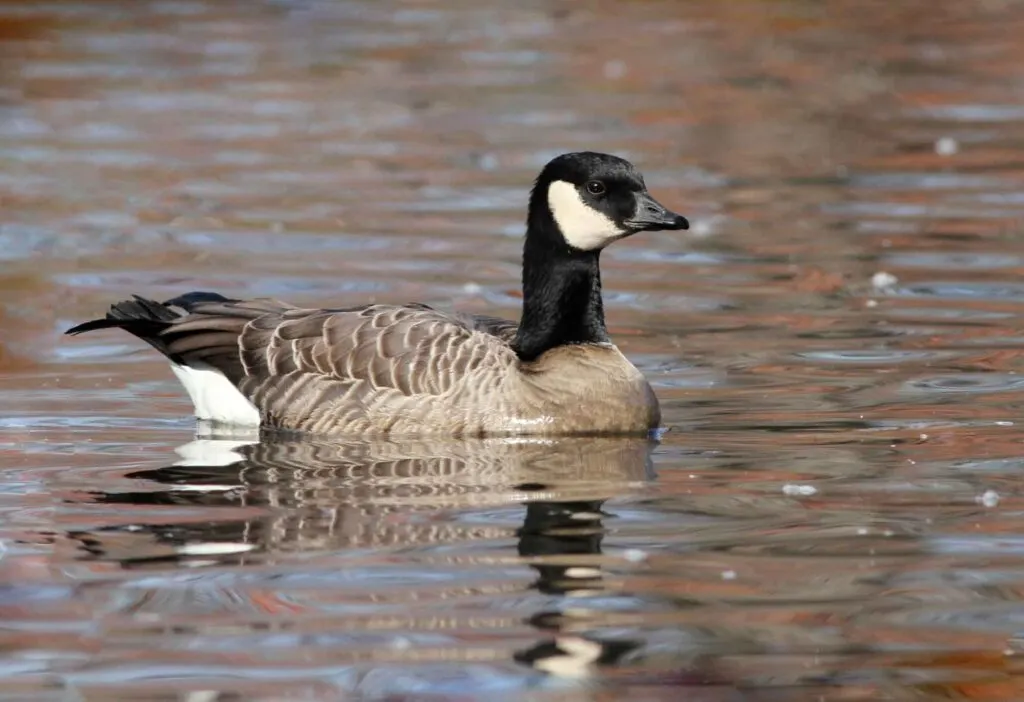
The cackling goose (Branta hutchinsii) is native to North America and was once considered a subspecies of the Canadian goose.
These types of geese nest in the tundra in ponds, streams, and other bodies of water.
Cackling geese are found in northern Canada, North America, and Alaska but migrate toward the pacific northwest during the winter.
The cackling goose weighs 3.5 pounds and resembles a smaller version of the Canada goose.
They nest and live in freshwater areas, grasslands, and wetlands. The cackling goose eats mostly plant matter but also eats insects and crustaceans.
The oldest living cackling goose was 22 years old. Cackling geese are known for their high pitch call and were appropriately named cackling geese because of this.
That’s it for today. Did you enjoy reading about these types of geese? Cool! Then share it on your social media!
Summarizing the 19 Fascinating Types of Geese
1. Brant Goose
2. Greater White-Fronted Goose
3. Spur-Winged Goose
4. Pink-Footed Goose
5. Ross’s Goose
6. Chinese Goose
7. Egyptian Goose
8. Canada Goose
9. Orinoco Goose
10. Bean Goose
11. Emperor Goose
12. Snow Goose
13. African Goose
14. Tufted Roman Goose
15. Swan Goose
16. American Buff Goose
17. Red-Breasted Goose
18. Barnacle Goose
19. Cackling Goose
